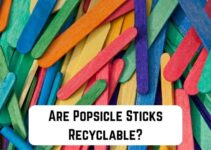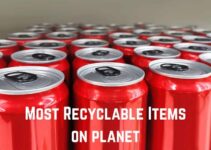One item we can all agree is fast becoming a commodity is chopstick. Its use in both homes and restaurants has given it this attained popularity. Though initially stemming from the Chinese and Japanese culture, it has gone around many parts of the world as a great culinary tool.
However, with this popularity comes some environmental concerns. The demand and supply have risen so high that people are beginning to wonder what might be the end of chopsticks after use? In this light, some questions touching down on the environment have been raised for considerations. For instance, how do we continue the use of chopsticks without posing harm to the environment? Are chopsticks even recyclable? What can you possibly do with your old chopsticks?
For us here, we understand all these questions, and many more are probably burning in your mind. That is why we have dedicated this post to provide answers to all of them. Below, you will get to find out if your favorite chopsticks are directly causing harm to the environment or not. We have also added some spice to this post by providing information on the beautiful things you can do with your old chopsticks.
You don’t want to miss out on any of this information. So why not sit back as we unleash valuable information about chopsticks to you!
Can You Recycle Chopsticks?
Recycling is now a widespread phenomenon that thankfully comes in handy when we need to dispose of things we do not need. No doubt, chopsticks’ frequent use only means that many used chopsticks are waiting to be disposed of. But then, can we adapt the process of recycling for chopsticks when attempting to dispose of them? Let’s find out together in the subsequent paragraphs.
The majority of chopsticks in use today are either made from plastic or wood. Though there are no specific labels to help recognize which is which, one thing we know is that plastic chopsticks are made from a raw material called polypropylene, and they can be recycled. Often, you will find a recycling sign on the chopstick, which signifies that its disposal should only be in the recycling bin.
However, for wooden chopsticks, the position is quite unclear because various policies and laws run interference in determining whether you can recycle wooden chopsticks. Most times, they are placed in the green bin and not recycled. But this does not mean they are completely useless. Since they are made of wood, they can be used for compost making and are easily biodegradable.
In all, when it comes to recycling, you don’t have to worry much. While plastic chopsticks are recyclable, wooden chopsticks can be used for other useful things like compost making.
Are Chopsticks Compostable?
There’s one thing about compost making, and that is the fact that only the materials that can easily breakdown are fit for making compost. This means that materials like the plastic used for chopsticks will not be compostable because they don’t breakdown. Plastic materials generally take hundreds of years to breakdown, and no one can wait for this to happen in a curbside compost bin.
On the other hand, wooden chopsticks stem from natural sources, so they are fit for making compost. However, depending on the type of wood used to make the chopstick, it may take months to finally break down.
Usually, to have quicker results with composting chopsticks, it is better to cut the wooden chopsticks into pieces. If possible, you can shred the chopsticks into sawdust. This will help the chopstick to the breakdown in due time.
Are Chopsticks Biodegradable?
As we mentioned earlier, chopsticks are of two types, and whether or not they are biodegradable depends largely on the type you are considering.
For the wooden chopsticks, they are largely biodegradable. The reason for this is because they are made from trees which is a natural material. In essence, when you use your wooden chopsticks and they end up in the landfill, you don’t have to worry much. In a matter of months, the chopsticks will biodegrade. When they biodegrade, they add to the nutrients of the soil because they are from natural sources.
On the other hand, plastic chopsticks cannot be said to biodegrade as easily as wooden chopsticks. Plastic materials take extremely long years before they break down. Even when they breakdown after hundreds of years, they only breakdown into microplastics that remain in the soil and reduce the soil’s quality while also stunting plants’ growth.
So, you see, when it comes to biodegradability, plastic chopsticks do not make the cut at all and are therefore a problem to the environment.
In the next segment, we will consider whether chopsticks are environmentally friendly or not.
Are Chopsticks Environmentally Friendly?
In the 21st century, the eco-friendliness of a product means a lot to everyone. That is why occasionally, questions to determine this are always popping up in both random and serious conversations. As expected, the same question has popped up in this conversation, and the right answer is what we are all seeking.
Chopsticks, both the plastic and wooden type, may be bad for the environment. Here’s the reason why.
For plastic chopsticks, it is pretty straightforward; the materials they are made of are not friendly to the environment. Except the plastic used for making these chopsticks are designed for recycling, they will probably become useless and end up in the landfill. Here, these plastic chopsticks don’t biodegrade, and they end up filling the landfill for thousands of years before they break down.
Before this occurs, the chances are that they would be blown away by the wind or washed away by the flood to undesired places where they will pollute the environment or cause harm to the living organisms there.
For the wooden chopsticks, the fact that they come from natural sources is what is causing negative effects on the environment.
Because wooden chopsticks are in high demand, many trees are cut down daily to keep up with production. This activity of cutting down trees to make chopsticks exposes the environment to disasters like flooding. Because trees are also a great source of oxygen for humans, cutting them down for chopsticks only takes away human’s means of livelihood.
So, in all, chopsticks appear to be bad for the environment. Till there’s a sustainable replacement for chopsticks, we might all have to cut down our demand for the use of chopsticks in restaurants and other places we use them.
Are Chopsticks Bad For The Environment?
As we pointed out above, chopsticks can be bad for the environment stemming from how they are being used and disposed of, and, of course, what they are being made of. For plastic chopsticks, they don’t decompose in real-time. This can cause ripple effects on soil fertility and pollute the surrounding environment when displaced by wind or flood.
For wooden chopsticks, their production material makes it bad for the environment. A product that requires the felling of thousands of trees cannot be said to be good for the environment.
In all, chopsticks may be useful, but they are potentially bad for the environment. What we would advocate is an environmentally sustainable replacement for both wooden and plastic chopsticks.
7+ creative Ways to Dispose of Old Chopsticks
Knowing what to do with old items will always be one of the best things in life. Asides from that, it gives those old things a new beginning; it also gives humans some sense of purpose because they are creating incredible things out of abandoned things.
There’s a lot we can do with old chopsticks to bring out our creativity in the situation at hand. In the subsequent paragraphs, some of these things would be brought to the limelight. Follow through to learn more.
1. Use As Soup Stirrers
This is one way you can put your chopsticks to use in the kitchen. Remember that chopsticks are strong and used for meals, so nothing stops you from using them to stir your soup. This can come in handy when you gently want to stir your soup without necessarily displacing the content.
2. Use As Dryers
If you have dealt with reusable Ziploc bags, you should know they can sometimes be difficult to dry after rinsing. You can get rid of this problem by using your chopsticks as dryers. All you have to do is put the chopsticks as a hanger for the Ziploc bags. This will hold in firmly and ensure proper air circulation within the bag.
3. Use As Hard Corner Cleaners
While cleaning, there are always those tight corners that your cleaning materials cannot reach but are important for you to clean. So, what do you do? Well, with chopsticks, you can reach those places and clean them. You can tie a tiny piece of cloths with a rubber band on one end of the chopstick for better effect. This will help you remove the dirt in those tight corners.
4. Use As Fire Kindler
If you have gathered enough chopsticks, you can save them up to kindle the fire during winter. This will work for only the wooden chopsticks. Occasionally, you can pop one or two chopsticks into the fire while you enjoy the heat with your loved ones.
5. Unclog Pipes
There is always minor plumbing work you can do, such as unclogging blocked pipes. If you are ever in this situation and need what to use, your chopsticks can come in very handy. They are long and tiny, so you do not have to worry about getting the job done.
6. Use As Hair Bun Holder
You can always stick chopsticks in your hair and use them to hold out your buns. This will help you to cut costs on some of the hair bun holders you have to buy.
7. Use As A Grill Turner
If you are grilling, you can always use chopsticks to turn your pork or meat. This will help you save a lot on the grilling equipment you have to buy.
8. Make Pegs
If you are running out of pegs, you don’t have to spend money to buy new ones. With your chopsticks, you can make yourself as many pegs as you want. You have to join two chopsticks together with a rubber band at the top and in the middle. This way, you can use the joined chopsticks to hold your clothes to the line.
Conclusion
No doubt, chopsticks have always been many people’s favorite cutlery and a great part of people’s meal. But this does not mean that their effects on the environment should be completely ignored.
While we all may not be able to eradicate their effect in a jiffy, we can do well by limiting how these things affect our environment. As you have seen above, we have explained different ways to go about this. The ball is now in your court.
References:
http://sharkscholar.com/2018/09/16/how-wooden-chopsticks-effect-the-environment/
https://www.instructables.com/Unusual-Uses-for-Chopsticks/
https://www.chinaeducationaltours.com/guide/culture-chopsticks-how-to-choose.htm






